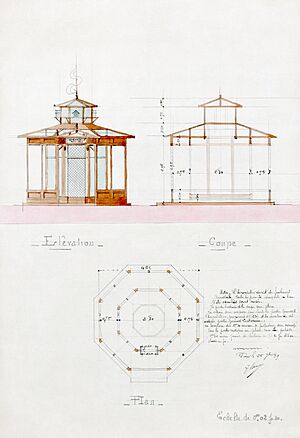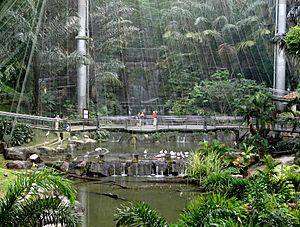Aviary facts for kids
An aviary is a special, large home for birds. Think of it as a super-sized birdcage! Birds have lots of space to fly around, just like they would in nature. You can find aviaries in many zoos. Some people also have them to care for birds or to help them have baby birds.
Contents
Exploring Different Aviaries
Public Aviaries: Big Homes for Birds
Public aviaries are huge bird homes you can visit. They are often found in zoos, like the famous London Zoo or the San Diego Zoo. Some places, like Jurong BirdPark in Singapore, are even entire parks just for birds!
The National Aviary in Pittsburgh is a great example. It's a large aviary that isn't part of a zoo. The Tracy Aviary in Salt Lake City, Utah, is another cool spot. It's a bird park right inside a public park.
Did you know some aquariums also have aviaries? Places like the Oregon Coast Aquarium have special aviaries for birds that live near water.
A Look Back: Aviary History

Aviaries have been around for a long time! People in the Aztec city of Tenochtitlan had large bird cages way back in the 1500s. The "Raven Cage" at the London Zoo was built in 1829. It's one of the oldest structures there.
The first big aviary inside a zoo was built in 1880 at the Rotterdam Zoo. In 1902, the National Zoo in Washington, D.C., opened its "flying cage." They built an even bigger one in 1964!
The Saint Louis Zoo has a special aviary from the 1904 World's Fair. It was the biggest bird cage ever built at that time! This huge cage is 228 feet (69 meters) long, 84 feet (26 meters) wide, and 50 feet (15 meters) high. It's still one of the world's largest free-flight aviaries.
In 1937, the San Diego Zoo opened its aviary. It was the largest in the world back then. This giant steel structure was 180 feet (55 meters) long and over 100 feet (30 meters) high! It was designed so birds could fly freely without beams getting in their way.
Later, zoos like the Frankfurt Zoo and Antwerp Zoo created new ways to show birds. They used glass walls and special lighting. Visitors could even walk among tropical birds in some areas.
The famous Snowdon Aviary at London Zoo was designed by Antony Armstrong-Jones, 1st Earl of Snowdon and opened in 1964.
The Bronx Zoo's World of Birds opened in 1972. It's a huge indoor exhibit with different bird habitats. You can walk through some areas where birds fly freely above you!
The Simmons Aviary at the Henry Doorly Zoo opened in 1983. It's one of the world's largest free-flight aviaries. About 500 birds from all over the world live there. This aviary is 4 acres (16,000 square meters) big. It's 800 feet (240 meters) long and 75 feet (23 meters) high in the middle. It uses strong nylon mesh instead of wire, which was a new idea!
The Birds of Eden bird sanctuary in South Africa is possibly the largest free-flight aviary in the world. It opened in 2005. It covers 21,761 square meters (234,230 square feet) and is home to about 3,000 birds from 200 different species.
Home Aviaries: Birds at Home
Some people who love birds have aviaries at home. These are popular with bird fanciers who have enough space. Many bird breeders use aviaries because bird pairs often breed better in them than in smaller cages.
You can build your own home aviary, or you can buy ready-made ones. They come in all sizes and fit different budgets.
There are two main types of home aviaries:
- Grounded aviaries: These are built on the ground. They usually have a concrete base. This stops small animals like rats from getting inside.
- Suspended aviaries: These aviaries hang in the air. Only their 'legs' touch the ground. This means they don't need a special base to keep out pests.
Grounded aviaries often have wood or PVC frames. Suspended aviaries usually have metal frames, like public aviaries.
Images for kids
-
The Bali Myna at Waddesdon Manor's Aviary in the UK.
-
The 1904 Flight Cage at the Saint Louis Zoo.
-
The Snowdon Aviary in London Zoo.
-
A spacious walk-in aviary at Jurong BirdPark in Singapore.
-
An aviary in the gardens of Schönbrunn Palace in Vienna, Austria.
-
The Victorian Aviary at Waddesdon Manor, a National Trust property in Buckinghamshire, built in 1889.
See also
 In Spanish: Aviario para niños
In Spanish: Aviario para niños









